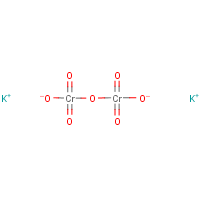Potassium dichromate
Agent Name
Potassium dichromate
Alternative Name
Potassium bichromate
CAS Number
7778-50-9
Formula
Cr2-O7.2K
Major Category
Metals

Synonyms
Bichromate of potash; Chromium potassium oxide (K2Cr2O7); Dichromic acid dipotassium salt; Dipotassium bichromate; Dipotassium dichromate; Dipotassium dichromium heptaoxide; Iopezite; Kaliumdichromat [German]; Potassium bichromate; Potassium chromate (K2Cr2O7); Potassium dichromate; Potassium dichromate (K2(Cr2O7)); Potassium dichromate (K2Cr2O7); Potassium dichromate(VI); SRM 935a; [ChemIDplus] UN1479
Category
Chromium Compounds, Inorganic
Description
Bright orange-red crystals; [ChemIDplus] Sparingly soluble in water at 20 deg C; [ACGIH]
Sources/Uses
Used as a dry cell depolarizer and in dyeing, staining, leather tanning, bleaching, and oxidizing; Also used in medical practice as an external astringent, antiseptic, and caustic; [ChemIDplus] Used with tungsten and iron in pyrotechnic displays; [CAMEO] Used in painting, printing, wood staining, fabric waterproofing, and corrosion inhibiting; also used to make safety matches and to bleach palm oil, wax, and sponges; [Merck Index] Used as an intensifier in photographic development; Also used as a mordant in textile dyeing; [www.ci.tucson.az.us/arthazards/medium.html]
Comments
CrVI compounds are irritants, sensitizers, and may be corrosive to the skin. CrVI compounds are respiratory tract irritants and may cause pulmonary sensitization. CrVI may cause acute tubular necrosis and liver injury. [ATSDR Case Studies] Corrosive to skin; [CAMEO] A hexavalent chromium compound; [CHEMINFO] See "Chromium" and linked occupational diseases.
Biomedical References
Exposure Assessment
Skin Designation (ACGIH)
Yes
Bioaccumulates
Yes
TLV (ACGIH)
0.0001 mg/m3, as Cr(VI), inhalable particulate matter
STEL (ACGIH)
0.0005 mg/m3, as Cr(VI), inhalable particulate matter
PEL (OSHA)
0.005 mg/m3, as Cr(VI)
Lethal Concentration
LC50 (rat) = 99 mg/m3/4 hr; [CHEMINFO]
NFPA
will not burn
Adverse Effects
Skin Sensitizer
Yes
Asthma
Yes
Hepatotoxin
Hepatoxic (a) from occupational exposure (secondary effect) or (b) in animal studies or in humans after ingestion
Nephrotoxin
Yes
Dermatotoxin
Skin burns
IARC Carcinogen
Established
NTP Carcinogen
Human carcinogen
ACGIH Carcinogen
Confirmed Human
Diseases, Processes, and Activities Linked to This Agent
Diseases
Occupational diseases associated with exposure to this agent:
Processes
Activities
Activities with risk of exposure: